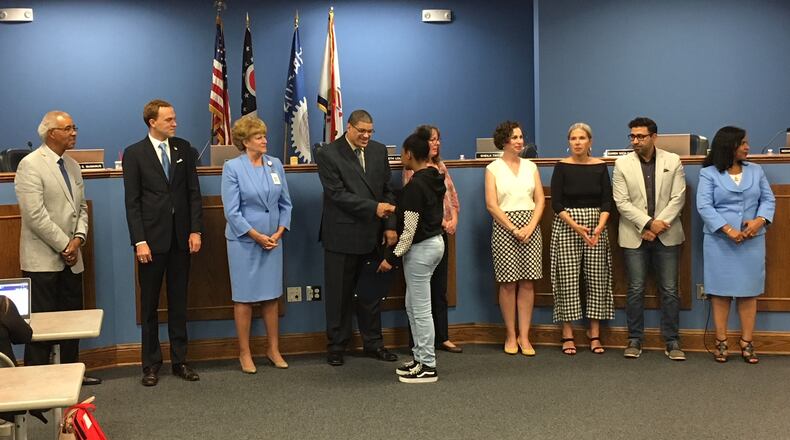RELATED: Dayton student challenges leaders to listen to teens
In late May, the school district approved a plan to use some of its $100 million-plus cash balance to make the repairs. Weeks later, they began discussing financing the work instead. McManus voted against the cash plan in May, questioned the financing idea in June, and on Tuesday said the switching of plans after the board had already voted was a bad sign, especially with board members mentioning tax levy possibilities in the near future.
“Now I may be wrong, but that seems to serve as some kind of evidence that perhaps there was insufficient planning,” McManus said. “My hope for the next board is, think through these decisions as best as you can because there are a lot of poor people, people with disabilities, people on fixed incomes. And everybody of every background is sending you their hard-earned money.”
Divisions are not new for Dayton’s seven-member school board. And since a new four-member majority took office in January 2018, McManus and Sheila Taylor have often complained that they are not involved in planning or discussions. Taylor, McManus and Robert Walker did not run for re-election and will be replaced in January by Gabriela Pickett, Will Smith and a third member pending a possible board of elections recount.
ELECTION: Smith, Pickett elected to Dayton school board
Board member Mohamed al-Hamdani immediately fired back, telling McManus he was wrong about this issue. Al-Hamdani quoted a presentation the previous week from DPS bond counsel John Payne suggesting that low interest rates mean borrowing instead of spending cash will cost only $1.4 million more.
Al-Hamdani said borrowing also will spread out the cost so that the district could wait longer before asking for a tax levy. The board approved a five-year financial forecast Tuesday that projects DPS spending will soar almost 14 percent this school year, going from $36 million in the black in 2018-19 to $14 million in the red for 2019-20.
The forecast suggests that deficit spending will increase rapidly, with the district going below its required budget reserve level in 2022-23 and completely running out of money in summer-fall 2023.
“Former boards decided well, we’re not going to invest that money. We’ll just let the buildings fall apart. Saving money was more important than taking care of our kids,” al-Hamdani said. “We also cut music programs, athletics, after-school and extracurricular activities because people thought it would save us money. But what it really did was kill our district. It killed our district. It killed our kids’ futures.”
RELATED: Ohio seeks to reinvent the high school experience
Dayton Public Schools has been near the bottom of Ohio’s rankings on state test results through a variety of different superintendents and school boards for decades.
Al-Hamdani’s comments angered longtime school board member Sheila Taylor.
“I really take offense at what you said. I think it’s ridiculous for you to sit up here as a board member and accuse. I’ve been on the board for 12 years, so everything you said is under my (term),” Taylor said, suggesting al-Hamdani did not have the institutional knowledge to understand how DPS had handled finances in the past. “You don’t spend your way out of a crisis, you manage your way out of a crisis.”
Earlier this decade, DPS reached a point where it kept less than 10 percent of a year’s expenses in the bank. Shortly after that, the district’s bond rating was downgraded, putting borrowing costs at risk. The bond rating was recently upgraded again, in part because the district now has about 45 percent of a year’s expenses in the bank.
RELATED: Dayton schools’ bond rating rises
Having that cushion is important to DPS because 70 percent of its general fund comes via state funding that can change every two years with the whims of the state legislature.
On Tuesday, McManus questioned why cost figures for repairs had changed multiple times this year. Early in 2019, the district had built more than $7 million extra into its budget for capital spending. This new money to be borrowed is on top of that.
Also, the plan-in-principle the school board approved in late May called for spending an additional $30 million ($10 million per year for three years) on building repairs. But the resolution the board approved Tuesday calls for $40 million over four years.
Asked about the discrepancy immediately after the meeting, al-Hamdani said it was “just to give us a little wiggle room.” He then approached President William Harris and Superintendent Elizabeth Lolli and mentioned the discrepancy in number of years.
About the Author

